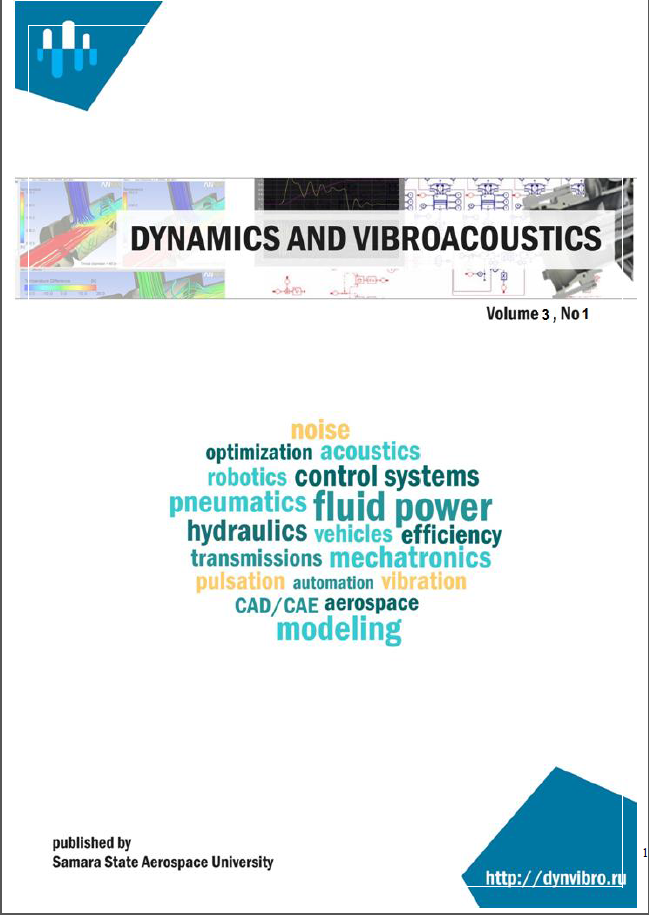Vol 3, No 1 (2016)
- Year: 2016
- Published: 16.03.2016
- Articles: 5
- URL: https://dynvibro.ru/dynvibro/issue/view/213
Full Issue
Articles
MEASURING AND PROCESSING DATA SYSTEM FOR DYNAMIC PROCESSES IN THE GAS TURBINE ENGINE GAS-AIR PATH DURING DEVELOPMENT TESTS
Abstract
Gas turbine engine dynamic stability research is an important stage of development tests aimed at ensuring its reliability. Finishing work is complicated by the fact that the engine stability depends on the interaction of many functional units, including compressor, combustor, turbine, and also on the mode of its operation and the large number of external factors. Purpose of the article is to ensure the process of testing facilities more information about the running engine gas-dynamic processes. It can speed up the identification of deficiencies in the design, elimination procedures and to reduce the finishing and final stage testing time to establish more accurately the engine stability actual border. To improve the reliability of the determination of the initial stage of occurrence of stall processes running in the engine, a new approach to the selection of monitored parameters – flexural vibrations of rotor blades and the pressure pulsations is proposed. The generalized structure of the system of collecting information on based on means to ensure the efficiency of the sensors used in these extreme conditions, operation, as well as the necessary dynamic performance is considered. Principles of these systems and a description of their operation are disclosed. The possibilities of the system to determine the shear phenomena options for calculating the parameters characterizing the bending vibrations of the blade and examples of presentation the results in graphical form are observed. The future proposed use of funds during normal operation of the engine is indicated.
 6-19
6-19


DIAGNOSTICS OF TECHNICAL CONDITION OF MULTISHAFT RACK GEARS ON THE BASIS OF THE ANALYSIS OF INTEGRAL INDICATORS OF ACOUSTIC ACTIVITY
Abstract
In article the possibility of simplification of procedure of diagnosing of mechanical drives on the basis of the analysis of changes of integral indices with use of opportunities of the modern hardware and software is considered.
 20-26
20-26


Vibrations of soil and foundation due to railway, blast and impact loading
Abstract
 27-38
27-38


STUDY OF THIRD-ORDER SYSTEM STABILITY IN THE SPACE OF CHARACTERISTIC EQUATION COEFFICIENTS
Abstract
The problem of building the stability space for third-order control system is solved. The 3D stability space has coefficients of characteristic equation as coordinates. Analytical conditions of system stability are defined. Different variants of crossing of stability border surface by coefficients of characteristic equation are considered. The analysis of changes in location of roots of system characteristic equation and in types of step responses under these variants is fulfilled.
 39-46
39-46


VIBROACOUSTIC DIAGNOSTICS OF OPEN-TYPE (UN-PRESSURIZED) SPACECRAFTS
Abstract
A special feature of the open design spacecraft is the presence of a CFRP (carbon-fiber reinforced plastic) cylinder around which three-layered honeycomb panels are fixed by means of pylons. The electronic equipment, antenna and feeder relay systems, units and instruments of the satellite control system are installed on these panels. Vibration loading of such structures is proposed to carry out both with the help of an electrodynamic shaker (up to 100 Hz) and a diffuse sound field in the reverberation chamber. The structure response to acoustic and vibration loading is fixed by accelerometers and presented in the form of amplitude-frequency characteristics and the power spectral density function of the random signal from the vibration frequency. The spacecraft defects are determined by parametric variations of its vibration response. To do this, vibration and acoustic tests are carried out in three stages. At the first stage the probing vibration loading the structure with low intensity is performed. Test results - resonant frequencies and vibration amplitudes – are compared with the design values or the values defined at the ground experimental development of the spacecraft. At the second stage the tests are performed at high loads, but in safe modes, calculated by a special technique. The third stage is a repetition of the first one. As a result, the defect location and nature are determined by the vibration parameters deviations. The article presents the methodology main statements and the spacecrafts vibroacoustic diagnostics results. It is concluded that the use of such diagnostics in the final stages of products manufacturing is reasonable.
 47-54
47-54











